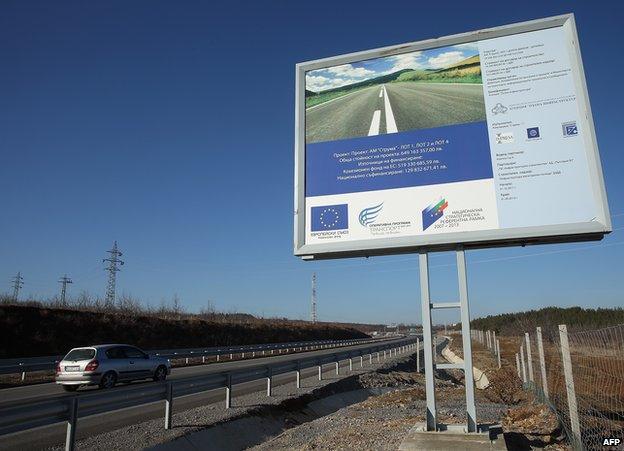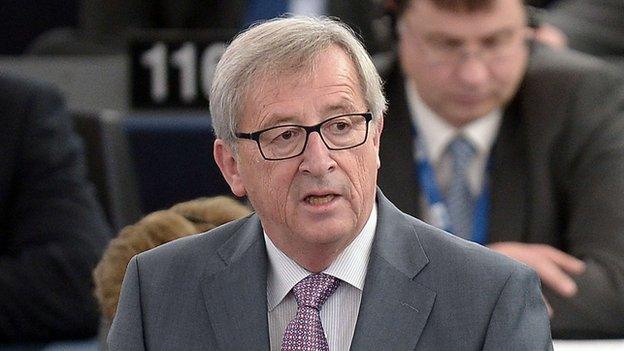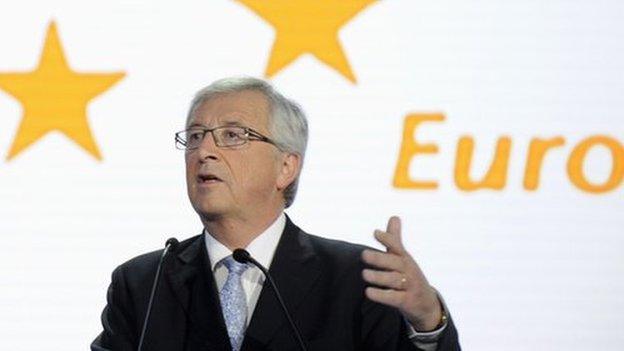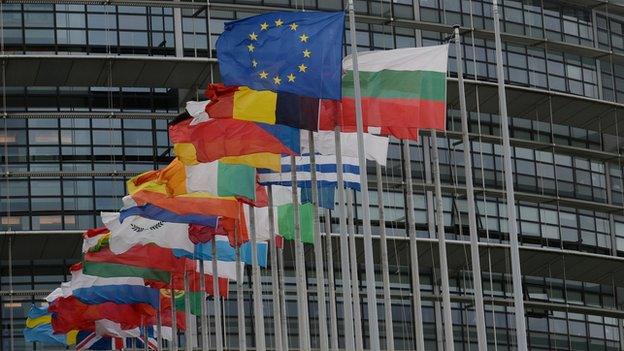EU investment: Juncker's cunning plan
- Published
- comments

EU regional funds are already used to modernise infrastructure across Europe, including this new highway in Bulgaria
The new European Commission President, Jean-Claude Juncker, appears to be staking a lot of credibility on an ambitious €315bn (£250bn; $392bn) scheme to boost private investment in European infrastructure projects.
It is the top item in the Commission's 2015 work programme, external, which he presented to the European Parliament on Tuesday.
But so far the reactions have been mostly cautious or sceptical.
There may be more enthusiasm for the plan at the EU summit on Thursday, where government leaders will consider how to make it work.
Many countries, including Germany, have delayed infrastructure improvements. There is an EU-wide need for better transport links, power grid connections, super-fast broadband, and school and hospital improvements.
The Commission is trying to allay any fears about expensive new EU "white elephant" projects, or special favours for pushy politicians.
The Commission promises a rigorous cost-benefit analysis by investment professionals, in which growth potential - including job creation - will outweigh any special-interest lobbying.

Mr Juncker is a specialist in finance - but this is a very ambitious scheme
Cash-strapped
One difficulty is that the Commission can put relatively little cash upfront, as national leaders are aware that most voters will not stomach much new EU-level spending in these times of economic hardship.
The "seed money" to launch the investment programme will total €21bn - that is, just €8bn of new EU cash, plus €8bn of existing EU budget funds and €5bn from the European Investment Bank (EIB).
The EIB, which has a top AAA rating, will use that money to provide guarantees to investors, the idea being that the EIB will cover the riskiest parts of any project. That is meant to reassure institutional investors and unlock some €315bn of private cash over three years.
The 28 member states have already submitted a huge wishlist of projects, external totalling €1.3 trillion.
Some of those submissions are not eligible. A project must be a public-private partnership, not one that is 100% publicly funded.
But at a time of national budget cuts some will ask whether the EIB should be doing this. Some national leaders might treat it as an excuse not to spend public money, relying instead on the EIB to do the heavy lifting.
Key ECB role
To kickstart the economic revival that Europe so desperately needs, the investment stimulus should be synchronised with a monetary stimulus from the European Central Bank (ECB), in other words "quantitative easing" (QE), argues John Springford at the Centre for European Reform (CER), who has analysed the Juncker scheme, external.
QE means the ECB buying huge quantities of sovereign bonds and other securities to release capital for investment - and the knock-on effect, analysts say, would be to nudge inflation up.
Germany's historic inflation fears and insistence on austerity have long delayed QE, despite pressure from France and other countries. Berlin's message to its eurozone partners remains: first rein in your budget deficits, before adding to your debts through expensive public works.
Eurozone priority?
There are other reasons why the investment scheme may be hard to pull off.
Turning €21bn into €315bn means "fifteen-times leverage, and there isn't a precedent for that in an investment fund using public sector money", Mr Springford told the BBC. "That is pretty high gearing even for banks."
National rivalry could also be an obstacle. "It seems the point of the fund is to help the eurozone, and the East Europeans are worried about that, especially the Czech government," Mr Springford said.
Only four small East European states have joined the euro so far.
Mr Juncker has warned that the EU, facing the risks of recession and deflation, is "in the last chance saloon".
New to the top job, he has already faced tough questioning over Luxembourg's controversial low-tax sweeteners for multinationals.
So giving the European saloon a successful makeover could make the EU's new "sheriff" more popular.
- Published15 July 2014

- Published9 December 2014
